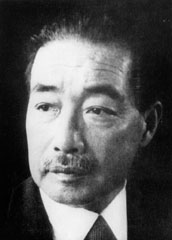Hakushū Kitahara
| Hakushū Kitahara | |
|---|---|

Hakushū Kitahara
|
|
| Born |
25 January 1885 Yanagawa, Fukuoka, Japan |
| Died | 2 November 1942 (aged 57) Kamakura, Japan |
| Occupation | Poet |
| Genre | poetry |
| Literary movement | Pan no kai |
| Notable works | Jashumon (Heretics, 1909) |
Hakushū Kitahara (北原 白秋 Kitahara Hakushū?, 25 January 1885 – 2 November 1942) is the pen-name of Kitahara Ryūkichi (北原 隆吉 Kitahara Ryūkichi?), a Japanese tanka poet active during the Taishō and Shōwa periods of Japan. He is regarded as one of the most popular and important poets in modern Japanese literature.
Kitahara was born in Yanagawa, Fukuoka prefecture, to a family of sake brewers. He attended the English literature department of Waseda University, but he left the university soon after without graduating. As a student he became interested in the poetry of Tōson Shimazaki, especially his Wakanashu (Collection of Young Herbs, 1897), which was written in the Shintaishi, or New Style, format.
In 1904, Kitahara moved to Tokyo and began submitting his poetry to various literary magazines. In 1906, he joined the Shinshisha (New Poetry Association) at the invitation of Yosano Tekkan, and he published poems in its magazine Myōjō (Bright Star) that brought him instant fame as a rising young poet, and served as an introduction to a wide circle of writers and poets. From these contacts, Kitahara formed his own literary group, the Pan no kai (The Society of Pan), which was innovative in including painters, musicians and actors as well as writers.
...
Wikipedia
